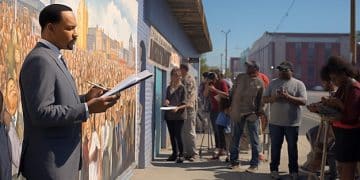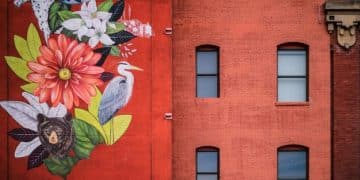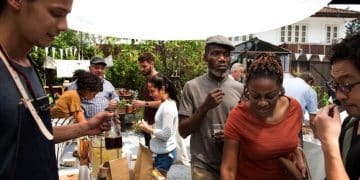NFTs for Local Artists: A 2025 Guide to Digital Art Success

The Rise of Digital Art: How Local Artists Can Leverage NFTs in 2025 explores how non-fungible tokens are transforming the art world, providing new avenues for local artists to monetize their work, build communities, and establish their presence in the digital landscape, particularly by 2025.
The art world is undergoing a radical transformation, and at the heart of it lies digital art and NFTs. The Rise of Digital Art: How Local Artists Can Leverage NFTs in 2025 presents a unique opportunity for local artists to connect with global audiences, monetize their creations in innovative ways, and redefine their artistic careers. This guide is designed to equip you with the knowledge and strategies needed to not only survive but thrive in this exciting new era.
Understanding the NFT Landscape
Non-fungible tokens (NFTs) have revolutionized how digital art is bought, sold, and collected. They offer local artists a direct path to global markets, bypassing traditional gatekeepers and enabling new forms of artistic expression. Understanding the basics of NFTs is crucial for any artist looking to navigate this landscape.
What are NFTs?
NFTs are unique digital assets that represent ownership of a particular item or piece of content. Unlike cryptocurrencies such as Bitcoin, each NFT is unique and cannot be exchanged on a like-for-like basis. This uniqueness is what makes them perfect for representing digital artwork.
The Role of Blockchain
NFTs exist on a blockchain, a decentralized and transparent ledger that records all transactions. This ensures the authenticity and ownership of the digital artwork, making it difficult to counterfeit or duplicate. Ethereum is the most popular blockchain for NFTs, but others like Solana and Tezos are also gaining traction.
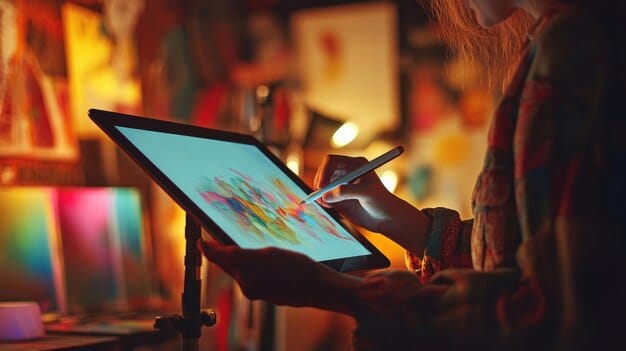
Here are key considerations regarding NFTs and blockchain:
- Smart Contracts: NFTs are governed by smart contracts, which automate the terms of sale and ownership, ensuring that artists receive royalties on secondary sales.
- Gas Fees: Minting and selling NFTs can incur gas fees, which are transaction fees paid to the blockchain network. These fees can vary depending on network congestion.
- Environmental Concerns: Some blockchains, like Ethereum, have been criticized for their energy consumption. However, newer blockchains and Ethereum’s transition to Proof of Stake are addressing these concerns.
Local artists need to grasp these fundamental concepts to effectively leverage NFTs and protect their work in the digital realm. Knowing the technology empowers artists to make informed decisions and build sustainable art practices.
Creating and Minting Your Digital Art as NFTs
Creating digital art and minting it as an NFT involves several key steps, from choosing the right format to selecting the appropriate marketplace. For local artists, this process can be both exciting and daunting, but with the right approach, it can open up new creative and financial opportunities.
Preparing Your Artwork
Before you can mint your artwork as an NFT, you need to ensure it’s in the right format. Common file formats for digital art NFTs include JPEG, PNG, GIF, and MP4 for video art. Consider the resolution and size of your file to balance quality and accessibility.
Choosing a Blockchain
Selecting the right blockchain is a crucial step. Ethereum is the most established, but it also comes with higher gas fees. Alternatives like Solana, Tezos, and Polygon offer faster and cheaper transactions, which can be appealing for artists starting out.
Minting Platforms
Minting platforms like OpenSea, Rarible, and Foundation allow artists to upload their artwork and turn it into an NFT. Each platform has its own set of features, fees, and community, so it’s important to do your research.
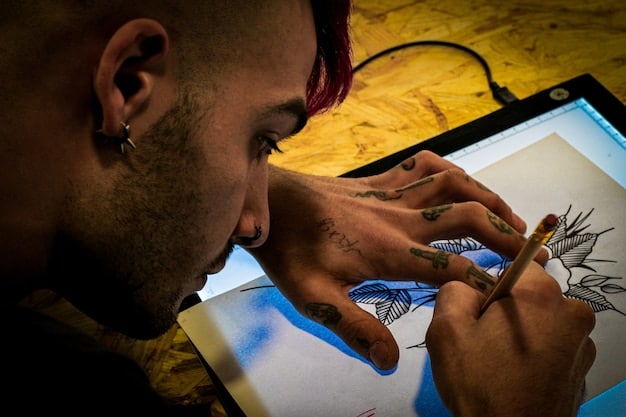
Key aspects of the minting process include:
- Setting a Price: Determine the price for your NFT, considering factors like rarity, artistic value, and market demand.
- Writing a Description: Create a compelling description that tells the story behind your artwork and highlights its unique qualities.
- Adding Metadata: Include relevant metadata, such as the artist’s name, creation date, and any special attributes of the artwork.
Once your NFT is minted, it’s ready to be listed for sale on the marketplace of your choice. Promoting your work and engaging with potential collectors is essential to driving sales and building your reputation.
Marketing Strategies for Local Artists in the NFT Space
Marketing is crucial to gain visibility and sell your NFT artwork. Without effective marketing, even the most exceptional art can go unnoticed. For local artists stepping into the NFT space, a strategic approach is essential to attract collectors and build a fan base.
Social Media Promotion
Leverage social media platforms like Twitter, Instagram, and TikTok to showcase your artwork and connect with potential buyers. Share behind-the-scenes glimpses of your creative process, engage with your audience, and participate in relevant NFT communities.
Collaborations and Partnerships
Collaborate with other artists, influencers, and NFT projects to cross-promote your work and reach new audiences. Partnerships can help you tap into existing communities and gain credibility in the NFT space.
Community Engagement
Engage with the NFT community by participating in discussions, attending virtual events, and supporting other artists. Building relationships with collectors and fellow creators can lead to valuable connections and opportunities.
Here are some additional marketing tips:
- Create a Website: Showcase your NFT artwork and provide information about yourself as an artist.
- Use High-Quality Images: Ensure your NFT artwork is displayed in the best possible quality to attract potential buyers.
- Run Contests and Giveaways: Generate excitement and attract new followers by hosting contests and giveaways featuring your NFTs.
Effective marketing strategies are essential for local artists to stand out in the crowded NFT market. By building a strong online presence and engaging with the community, artists can increase their visibility and drive sales.
Legal and Financial Considerations for NFT Artists
Navigating the legal and financial aspects of selling NFTs is crucial for local artists to protect their rights and manage their income effectively. Understanding copyright, royalties, and tax implications can help artists avoid potential pitfalls and build a sustainable business.
Copyright and Intellectual Property
As an artist, it’s essential to understand your rights regarding copyright and intellectual property. When you mint an NFT, you’re essentially creating a digital representation of your artwork, and you retain the copyright to that artwork unless you explicitly transfer it to the buyer.
Royalties and Smart Contracts
Smart contracts can be programmed to ensure that you receive royalties on secondary sales of your NFT. This means that every time your artwork is resold on the marketplace, you’ll automatically receive a percentage of the sale price. Make sure your smart contract includes a royalty provision.
Tax Implications
Selling NFTs can have tax implications, depending on your location and the amount of income you generate. It’s important to consult with a tax professional to understand your obligations and ensure you’re complying with all applicable laws.
Here are some additional considerations for NFT artists:
- Legal Agreements: Consider using legal agreements, such as terms of service and privacy policies, to protect your rights and manage your relationship with buyers.
- Insurance: Explore insurance options to protect your digital assets from theft or loss.
- Financial Planning: Develop a financial plan to manage your NFT income and ensure you’re saving for the future.
Understanding the legal and financial aspects of selling NFTs is crucial for local artists to protect their artwork, manage their income, and build a sustainable career in the digital space. Seeking professional advice can help artists navigate these complex issues and make informed decisions.
Building a Community Around Your Art
Creating a loyal and engaged community around your art is vital for long-term success in the NFT space. A strong community can help you promote your work, generate sales, and provide valuable feedback and support. For local artists, building a community can be a powerful way to connect with collectors and fellow creators.
Engaging with Fans
Interact with your fans on social media, respond to comments and messages, and show appreciation for their support. Building personal relationships with your audience can foster loyalty and encourage them to become advocates for your work.
Hosting Events
Organize virtual events, such as live Q&A sessions, art demonstrations, and NFT drops, to engage with your community and showcase your artwork. Events can create a sense of excitement and exclusivity, driving interest in your NFTs.
Creating Exclusive Content
Offer exclusive content, such as behind-the-scenes videos, early access to new artwork, and limited-edition NFTs, to reward your loyal supporters and incentivize them to stay engaged with your community.
Some additional strategies for community building include:
- Discord Server: Create a Discord server to provide a dedicated space for your community to connect, discuss your art, and share ideas.
- Mailing List: Build a mailing list to communicate directly with your fans and keep them informed about upcoming events, NFT drops, and other news.
- Collaborative Projects: Involve your community in collaborative art projects, allowing them to contribute ideas and participate in the creative process.
Community building is an ongoing process that requires dedication and effort. By engaging with your fans, hosting events, and creating exclusive content, local artists can foster a strong and supportive community that helps them thrive in the NFT space.
Future Trends and Opportunities in Digital Art and NFTs
The world of digital art and NFTs is constantly evolving, with new trends and opportunities emerging all the time. Staying informed about these developments is crucial for local artists to remain competitive and capitalize on new possibilities. In 2025, several key trends are expected to shape the landscape of digital art and NFTs.
Metaverse Integration
The metaverse, a virtual world where users can interact with each other and digital objects, is poised to become a major platform for digital art and NFTs. Artists can create virtual galleries and exhibitions in the metaverse, allowing collectors to experience their artwork in immersive and interactive ways.
AI-Generated Art
Artificial intelligence (AI) is increasingly being used to create digital art, and this trend is expected to continue in 2025. AI-generated art can offer new creative possibilities for artists, allowing them to explore different styles and techniques and even collaborate with AI algorithms.
Cross-Chain Interoperability
As more blockchains emerge, the need for cross-chain interoperability is growing. This would allow NFTs to be easily transferred and traded across different blockchains, increasing their liquidity and accessibility. Projects like Polkadot and Cosmos are working to enable cross-chain interoperability.
Here are some additional trends to watch out for:
- Fractionalized NFTs: Fractionalized NFTs allow multiple people to own a share of a single NFT, making high-value artwork more accessible to a wider range of collectors.
- Dynamic NFTs: Dynamic NFTs can change over time based on external data or events, creating new possibilities for interactive and engaging artwork.
- NFT-Backed Loans: NFT-backed loans allow collectors to borrow money using their NFTs as collateral, providing a new source of liquidity for the NFT market.
The future of digital art and NFTs is full of exciting possibilities. By staying informed about emerging trends and opportunities, local artists can position themselves for success in this dynamic and rapidly evolving space.
| Key Point | Brief Description |
|---|---|
| 🎨 NFT Basics | Understanding NFTs, blockchain, and smart contracts |
| 💰 Monetization | Leveraging NFTs for art sales and royalties |
| 📣 Marketing | Strategies to promote NFTs and build community |
| 🔮 Future | Trends like metaverse, AI art, and interoperability |
FAQ
▼
An NFT (non-fungible token) is a unique digital asset that represents ownership of an item. In digital art, this means that an NFT can provide verifiable proof of ownership for a piece of artwork, making it possible to collect and trade digital art in a secure manner.
▼
Local artists can benefit from NFTs by gaining access to global markets, receiving royalties on secondary sales, and building a direct connection with their fans. NFTs also enable new forms of artistic expression, such as dynamic and interactive artwork.
▼
Minting involves turning a digital file into a unique NFT on a blockchain. This typically involves uploading the artwork to a minting platform, setting a price, writing a description, and adding metadata. The platform then creates a smart contract that governs the NFT.
▼
Effective marketing strategies include promoting your work on social media, collaborating with other artists, engaging with the NFT community, creating a website, and running contests and giveaways. Building a strong online presence is key to attracting potential buyers.
▼
Selling NFTs can have tax implications, and it’s essential to manage your income effectively. Consult with a tax professional to understand your obligations and ensure you’re complying with all applicable laws. Also, consider legal agreements to protect your rights.
Conclusion
As we look towards 2025, the integration of NFTs into the art world offers unprecedented opportunities for local artists. By understanding the technology, creating compelling artwork, implementing effective marketing strategies, and building strong communities, artists can leverage NFTs to unlock new revenue streams and connect with global audiences, shaping the future of digital art.

